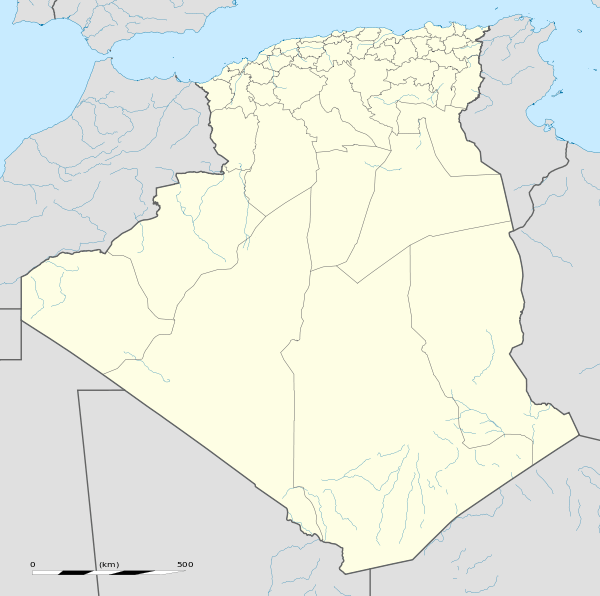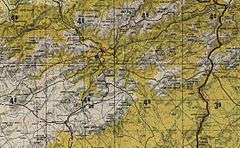Souk Ahras
| Souk Ahras Suq Ahras / Tagast سوق أهراس /طاغاست | |
|---|---|
| City and Commune | |
| City of Souk Ahras | |
|
The Golden Lion of Souk Ahras Symbol of the town | |
 | |
 Souk Ahras Location of Souk Ahras within Algeria | |
| Coordinates: 36°17′11″N 7°57′4″E / 36.28639°N 7.95111°ECoordinates: 36°17′11″N 7°57′4″E / 36.28639°N 7.95111°E | |
| Country |
|
| Province | Souk Ahras (seat) |
| District | Souk Ahras (coextensive) |
| Government | |
| • PMA Seats | 33 |
| Area | |
| • Total | 812 km2 (314 sq mi) |
| Elevation | 699 m (2,293 ft) |
| Population (2011) | |
| • Total | 156,745 |
| • Density | 190/km2 (500/sq mi) |
| Time zone | CET (UTC+01) |
| Postal code | 41000 |
| Area code(s) | +213 (37) |
| ONS code | 4101 |
| Website | www.soukahrastourisme.com |
Souk Ahras (Berber: Suq Ahras or Tagast; ancient name: Thagast; Arabic: سوق أهراس) is a municipality in Algeria. It is the capital of Souk Ahras Province. The Numidian city of Thagaste (or Tagaste), on whose ruins Souk Ahras was built, was the birthplace of Augustine of Hippo and a center of Berber culture.[1][2] It was a city of great culture, described as the very hub of civilization.[3]
Etymology
The name derives from the Arabic word "souk" which means market, and the Chaoui Berber word ahra (plural ahras) which means lion, in reference to the Barbary lions which existed in the neighboring forests until their extinction in 1930; hence Souk Ahras means market of lions (see also Oran (Wahran) and Tahert for names with a related etymology).
| Year | 1877 | 1878 | 1879 | 1880 | 1881 | 1887 | 1891 | 1892 |
| Lions | 3 | 4 | 5 | 3 | 1 | ? | 1 | ? |
| Leopards | 2 | 7 | 5 | 7 | 2 | 8 | 2 | 4 |
The old name of the Numidian city of Thagaste, derives from the Berber Thagoust, which means the bag, given that the site of the town is located at the foot of a mountain surrounded by three peaks in the form of a bag containing the city. Subsequently, when the Arabic language entered in the region it was called Soukara. In other sources it is cited as the Palace of the African, according to Al-Masudi.
History
Prehistory
The town of Souk Ahras, as its region, experienced Aterian culture from the end of the Middle Palaeolithic to the early upper Palaeolithic Ages. After the Aterian, Souk Ahras was inhabited by people of the Capsian culture. Many stone tools dating to this period have been discovered. Stemmed arrows were found on the site of present-day Souk Ahras, but also in Tiffech and Taoura, not far from it.
Antiquity
It was the birthplace of Augustine of Hippo (born 13 November 354 CE) to Monica of Hippo (Saint Monica), he later the Bishop of Hippo and Saint Augustin.[4] Souk Ahras (Thagaste) has played an important role in the political and cultural history of the region because of its strategic position at the crossroads of Numide, Ancient Roman, and Berber civilizations. It was the location of military fortifications (Madaure, Tiffech, Khemissa...) and urban centers.
Thagaste
The Numidian city of Thagaste or Tagaste, on whose ruins Souk Ahras was built, was situated in the north-eastern highlands of Numidia. It was about 60 miles (97 km) from Hippo Regius, (present day Annaba), 20 miles (32 km) southwest of Thubursicum (present day Khamissa), and about 150 miles (240 km) from Carthage (on the coast of present-day Tunisia).
Thagaste became a Roman municipium.[5] The city was mentioned by Pliny the Elder. As a municipium, Thagaste was not settled by Roman Italian immigrants, but was inhabited by Romanized native Berbers.[6]
Modern era
In 1830 Souk Ahras became a colonial settlement of French Algeria (1830 – 1962). Late 19th century connection via the Algerian Railway, and 20th century iron ore and phosphate mining, brought some modern significance and prosperity to the town.
During the Algerian War of Independence (1954 - 1962), Souk Ahras housed the Ouled Bechiah Mounts as an autonomous military base of the Army of National Liberation (ALN), called "Basis of the East".
Geography
Relief and hydrography
The town of Souk Ahras is located in a basin surrounded by wooded mountains as the Djebel Beni Salah or Djebel Ouled Moumen.
Souk Ahras is crossed by a major North African river, the Medjerda.
Three dams exist in the region of Souk Ahras, that of Ain-Edalia supplies the town of Souk Ahras and its region with 76 million cubic meters. Dams of Oued Charef and Djedra, provide a capacity of 153 and 35 million cubic meters, respectively. Dam Djedra is intended to supply the town of Souk Ahras with a quantity of 12 million cubic meters of potable water, while 2 million cubic meters will be pumped for irrigation.
 Souk Ahras topographic map
Souk Ahras topographic map the Medjerda river
the Medjerda river the Ain-dalia dam
the Ain-dalia dam
Districts of Souk Ahras

- Souk Ahras
- An-Nasser
- Diar Ezzarga
- 1er Novembre 1954
- 5 Juillet
- 17 Octobre
- 20 Août
- 26 Avril 1958
- El-Allaouia
- Ibn Rochd
- Kouicem Abdelhak
- Sidi Messaoud
- Sidi Okba
- Et-Tagtaguia
Climate
Algiers has a Mediterranean climate with warm summers and mild winters. Its proximity to the Mediterranean Sea aids in moderating the city's temperatures. As a result, Souk Ahras usually does not see the extreme temperatures that are experienced in the adjacent interior deserts. The climate of Algiers, like that of other Atlas cities, features wet winters and dry summers. Souk Ahras on average receives roughly 840.74 mm (33.1 in.) of precipitation per year, the bulk of which is seen between October and April.
| Climate data for Souk Ahras | |||||||||||||
|---|---|---|---|---|---|---|---|---|---|---|---|---|---|
| Month | Jan | Feb | Mar | Apr | May | Jun | Jul | Aug | Sep | Oct | Nov | Dec | Year |
| Average high °C (°F) | 13.9 (57) |
15 (59) |
17.8 (64) |
20.6 (69.1) |
25 (77) |
30 (86) |
35 (95) |
35 (95) |
30.6 (87.1) |
25.6 (78.1) |
20 (68) |
15 (59) |
22.8 (73) |
| Daily mean °C (°F) | 8.9 (48) |
10 (50) |
11.7 (53.1) |
13.9 (57) |
17.8 (64) |
21.7 (71.1) |
25.6 (78.1) |
26.7 (80.1) |
22.8 (73) |
18.9 (66) |
13.9 (57) |
10 (50) |
16.7 (62.1) |
| Average low °C (°F) | 3.9 (39) |
3.9 (39) |
5.6 (42.1) |
6.7 (44.1) |
10.6 (51.1) |
13.9 (57) |
16.7 (62.1) |
17.8 (64) |
15.6 (60.1) |
11.7 (53.1) |
7.8 (46) |
5 (41) |
10 (50) |
| Average precipitation mm (inches) | 111.76 (4.4) |
81.28 (3.2) |
101.6 (4) |
71.12 (2.8) |
45.72 (1.8) |
22.86 (0.9) |
2.54 (0.1) |
10.16 (0.4) |
45.72 (1.8) |
104.14 (4.1) |
109.22 (4.3) |
137.16 (5.4) |
840.74 (33.1) |
| Source: World Meteorological Organization (UN)[7] | |||||||||||||
Demographics
The inhabitants of the town of Souk Ahras are of Berber origin. They are mainly from the different regions of the wilaya of Souk Ahras and neighboring wilayas. The first tribes having established in Souk Ahras were known as the Papiria,[8] or Babiria from the name of Berber. They were composed of Causses and Syliactae.[9]
The tribes of Mousoulami and Kirina lived there. Including the other tribes: the Hnanchas that grew the most and the Hrakta all of them have Berber origins. These tribes lived in tents and practiced nomadism. They have established later and founded cities for each of them, including the town of Souk Ahras, the old Thagaste.
| Year | 1901 | 1926 | 1948 | 1954 | 1960 | 1966 | 1974 | 1977 | 1987 | 1998 | 2010 |
|---|---|---|---|---|---|---|---|---|---|---|---|
| Population | 7500 | 10600 | 17025 | 20700 | 22800 | 34400 | 52100 | 57173 | 80015 | 115882 | 157329 |
People related
- Augustine of Hippo, Doctor of the Church
- Martianus Capella, author
- Apuleius, author
- Alypius of Thagaste, bishop celebrated on August 15
- Firmus and Rusticus, Christian martyrs (4th century)
- Tacfarinas, resisted Roman invasions
- Ahmad al-Tifashi, author
- Kateb Yacine, author
- Tahar Ouettar, author
- Taoufik Makhloufi, middle distance runner and gold medalist at the 2012 Summer Olympics
- Chabane Boualleg: psychologist and senator
References
- ↑ "A Berber, born in 354 at Thagaste (now Souk-Ahras) in Africa...", Fernand Braudel, A history of civilizations (1963), Penguin Books, 1995, p.335
- ↑ "...he grew up in an area which was a center of Berber culture.", Augustinian studies, Volumes 7–8, Villanova University Press, 1976, p.134
- ↑ Elbert Hubbard's Selected Writings By Fra Elbert Hubbard. Time and Chance. p. 435. Retrieved August 4, 2012.
- ↑
 Herbermann, Charles, ed. (1913). "Thagaste". Catholic Encyclopedia. New York: Robert Appleton Company.
Herbermann, Charles, ed. (1913). "Thagaste". Catholic Encyclopedia. New York: Robert Appleton Company. - ↑ A municipium was an existing city on which the citizenship had been conferred, while a colony was a new foundation or a community to which Roman settlers had been added
- ↑ Nacéra Benseddik, Thagaste. Souk Ahras, ville natale de saint Augustin, Ed. Inas, Alger, 2005, p.25
- ↑ "Weather Report for Souk Ahras".
- ↑ Enciclopedia italiana di scienze, lettere ed arti, Volume 33, Giovanni Gentile, Calogero Tumminelli, Istituto Giovanni Treccani, Rome online version
- ↑ Vita Augostino di H'sen Dardour online version
Bibliography
- Nacéra Benseddik (2005). Thagaste. Souk Ahras, ville natale de saint Augustin. Algiers: Ed. Inas.
- Serge Lancel (2002). Saint Augustine, Hymns Ancient & Modern. Chapter I: Ltd. pp. 3–7.
- "The Martyrs of Madaura". Retrieved July 18, 2012.
External links
| Wikimedia Commons has media related to Souk Ahras. |
- www.souk-ahras: Souk Ahras Info
- Panoramio — Image gallery about Souk Shras and its region
- Falling Rain Genomics, Inc. "Geographical information on Souk Ahras, Algeria". Retrieved 2008. Check date values in:
|access-date=(help)
 |
Guelma | Annaba | El Kala |  |
| M'Daourouch | |
Ghardimaou (Tunisia) | ||
| ||||
| | ||||
| Oum El Bouaghi | Tebessa | El Kef (Tunisia) |
